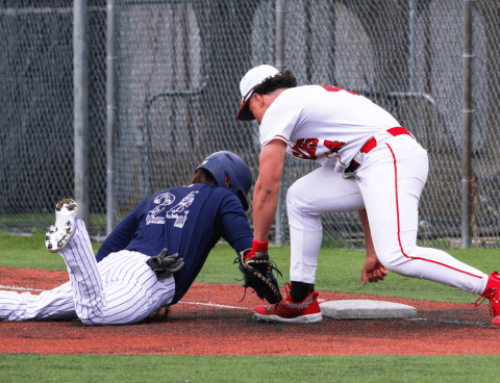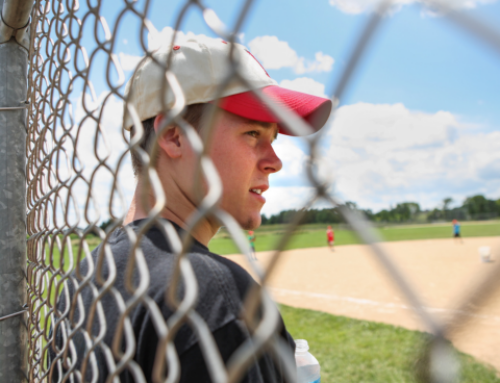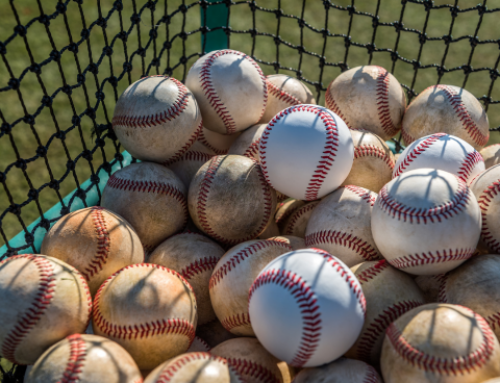Baseball Skills with the Boston Red Sox
Click here for additional Red Sox ChangeUp Grips
When it comes to making a delivery, FedEx has nothing on Curt Schilling. The power of an enraged bull can’t stand up to that of Manny Ramirezs bat, which consistently parks balls outside the Green Monster. And even Caesar himself couldn’t lead a field of men like Jason Varitek. These men and the rest of the 2004 Boston Red Sox led the League in seven offensive categories, tied the record for doubles and brought the World Championship back to Beantown for the first time in 86 years. The 2005 campaign was impressive as well; the Sox capped off a thrilling late season drive by securing a spot in the divisional series.
Making history, however, didn’t come without the help of three great instructors: Hitting Coach Ron Papa Jack Jackson, who’s been with Boston since 2002; Pitching Coach Dave Wallace, who joined the team full time in 03; and Bench Coach Brad Mills, whose BoSox initiation came in 2004 following a stint with the Expos.
Take an inside look at the curse-crushing instruction that propelled the Red Sox to the top of the American League.
At the plate with Ron Jackson
Papa Jack drops a few lines about hitting skills.
Two-strike hitting
The key to hitting with two strikes is tracking the ball deeper into the catchers mitt. Good hitters can see the ball longer than everyone else.
Most hitters either choke up on the bat or widen their stance to help their chances with two strikes. Choking up shortens your swing, making your hands quicker to inside pitches. Spreading your stance can help you see the ball better, prevent you from being fooled by a pitch and stop you from overstriding. When a batter overstrides, his head moves toward the ball, creating the illusion that the ball is moving faster than it really is. Be easy with your body and quick with your hands.
Without two strikes, part of the plate belongs to the batter. If the first few pitches aren’t exactly where you want them, you can just take them. But when your count includes two strikes, the plate widens, leaving more for you to cover. This is really when you have to see the ball.
The art of the sac fly
Focus on hitting from gap to gap. Look for a ball up in the zone if possible, and drive it between left- and right-center the deepest part of the ballpark. But don’t try to lift the ball. If you alter your swing too much, you’ll hit a pop-up. Pitchers try to induce grounders by throwing the ball down in the strike zone when the batter is looking to advance a runner. You have to learn how to get the ball in the air off a low pitch through constant cage work.
Hit and run
You don’t want to alter your swing too much in this situation either. Most managers are just looking for a ground ball. Having a guy like Mark Loretta on your team is great, because he has enough bat control to hit behind the runner or move an inside pitch to the right. But since making contact is hard enough, just concentrate on that. When you try to aim the ball, you end up dipping your bat head and popping up.
Since the runners are moving, you don’t get to pick your pitch in this situation. But realize that a ball low in the zone is easier to hit on the ground. You need to practice hitting ground balls off pitches in all locations, because you can’t wait for the one.
Pitch recognition
You were born and raised to hit that number one pitch-the fastball. And many times, players don’t see enough good breaking balls early in their careers, so they never learn how to hit one.
When I coach younger players, I tell them to always take the breaking ball. Most times, a curve or slider will be out of the zone, because most young pitchers can’t throw them for strikes. Lay off these pitches, so you don’t even flinch at them. Then, if a pitcher hangs a breaking ball, you’re going to swing, because it looks like a fastball with nothing on it. That’s the pitch you crush.
Don’t ever look for a pitch instead, react to the ball as it comes. Create a little window around the pitchers release point and focus on it. Watch him warm up; see if he throws sidearm, three-quarter or over the top. Pay close attention to his release point for certain pitches. Then, when you’re focusing on the window, you’ll quickly recognize what pitch is coming.
Hitting the deuce
Gaining the ability to hit a curve ball results from repetition, seeing that pitch a lot and hitting it just like learning to hit off a lefty.
When you realize the pitcher is delivering a curve, see the ball as long as you can and try to hit the inside of the ball. If you try to swing around it, you’ll miss it or hook it foul. For a right-handed batter, if the ball is breaking away from you and you stay inside to aim up the middle or right-center, you’ll hit it straight. If it is breaking toward you and you stay inside it, you’ll still hit it fair, but down the leftfield line.
On the mound with Dave Wallace
Accelerate your K count with this coach’s advice.
The Fastball (Heater)
Every young pitcher needs to gain command of his fastball. It builds arm strength and can evolve into a few different pitches if you can control and locate it.
Down and away
Locating a fastball down and away has to be a pitcher’s number one priority. Look at the bat angle of a hitter trying to make contact there. His barrel is below the handle, so making quality contact is difficult.
Up and in
The next best location is up and in, just under the hitter’s elbows. Putting the ball there can back the hitter off the plate or tie him up if he swings.
Ideally, use this placement in a 1-2 or 0-1 count to back a guy off and avoid going too deep into the count. Its a great delivery when its a pitcher’s count and you can afford to go off the plate, but still have the effectiveness of setting up the next pitch. However, making a mistake with this pitch in a tight situation usually puts the ball over the plate right where a batter likes it.
The Grip
There are two main grips to hurling a fastball the two-seam (sinking) and four-seam (rising); it just depends on your preference. Most guys throw a four-seam. If a guy throws 90-plus miles per hour with the four-seam, that’s great. But if he’s throwing an 87-mile-per-hour two-seam sinker, then I want him to stay with that until he’s ready to advance to the four-seam.
The Curve (Hook)
The curve ball is a great weapon because it changes planes on the batter. It looks like it’s coming in on one level, then breaks to another. Changing the plane or eye level of a hitter’s swing is always to your benefit.
Technique
Most young pitchers try to throw a curve too hard. Instead of emphasizing velocity, focus on creating spin. Once your arm gets to shoulder level-in the L-position-turn your wrist in and pull down on the ball rather than casting it out. You should end up pulling almost straight down. The quicker the spin (not the harder the throw), the quicker the pitch breaks through the hitting zone.
Grip
This all depends on your comfort. Whatever grip you use, however, the ball should have a rapid downward rotation when it comes out of your hand.
When to throw the deuce
If a pitcher can use the curve as a get over pitch, then he should use it as the first pitch. It will probably be a strike, because it’s unlikely the batter will swing. The curve is also great for later in the count when you see that your hitter is anxious to swing. Play to his aggressiveness by throwing the curve out of the zone. Even though it’s not a strike, it will look like one at first, so he’ll commit and swing.
The Changeup (Dead Fish)
Mastering the changeup is a necessity. You deliver it with the same arm speed and rotation as your fastball, but less velocity, which produces less wear on your arm and is harder for hitters to time. I don’t care if it’s an 81-, 86- or 96-mile per hour fastball. The whole basis of pitching effectively is upsetting the hitter’s timing, and there is no better way to do that than with the changeup.
Grip
You have to use a grip with which you can actually throw a fastball. Your arm speed and release look like a fastball is coming, but you have to take something off it with your grip-ideally 10 to 12 miles per hour.
To do this, put the ball back in your fingers. You can use the circle change, which is where you grip the ball toward your palm with your middle, ring and pinky fingers and make an OK sign on the ball with your index and thumb. Or you can try the three-finger change. Grip the ball down toward the palm with your index, middle and ring fingers, and touch your thumb and pinky together under the ball. You have to experiment with the changeup grips to learn how to deaden the ball as you release it.
In the field with Brad Mills
Take the field with Mills mental edge.
Infield strategy
Runners on first and third
Although most first and third situations begin with a catcher’s throw down to second, there are several ways to handle them. The basic play is to throw the ball down to second to get the man from first. As an alternative, the second baseman or shortstop can cut off the throw to get the man heading home. Or, the catcher can give the effect he is going all the way to second, but throw a hard shot back to the pitcher. The pitcher can then make the play to get the guy between third and home. Finally, the catcher can throw to third right away to get the runner in case he breaks too early.
You want to prevent big innings early in a game, so you might want to let the other team score from third to get the out at second. Outs are more important than runs at that point. Later in the game-when your team has fewer at bats and potential scoring opportunities left-you should aim for the guy at third and allow the other runner to take second.
Steal situation
Middle infielders have to signal each other to determine who’s covering the bag on a steal. Teams usually use an open or closed mouth covered by a glove to relay this information. Open mouth means you have it, and closed means I have it.
Typically, the type of pitcher and hitter determine who covers the bag. If it’s a right-handed pull hitter, you don’t want the shortstop covering, because there’s a better chance the ball will be hit to his side. The opposite is true if its a right-handed slap hitter who doesn’t get around on the ball. If your pitcher has a lot of velocity on his ball, batters are less likely to get around on it, so the shortstop has to cover the bag.
Turning two
The second baseman and shortstop have to make sure they don’t give up the hole by breaking to the bag too early. They should be at number two depth-a couple of steps in and straight on-to allow them to hold ground a bit longer while still getting to the bag in time.
Outfield strategy
With bases clear
When an outfielder is coming up on a routine hit with no one on base, he should field the ball with more security. He cannot let the ball get by to give up extra bases. He should field almost like an infielder. Some coaches like outfielders to get on one knee to field the ball, but I prefer they don’t.
With men on
When a batter gets a base hit with guys on, you have to field the ball more aggressively to stop the runners from taking an extra base. Come up and field the ball on the glove side of your body while maintaining momentum toward the infield.
When a fly ball is hit, I like outfielders to approach it with some flex in their knees and hips. This athletic position helps them read and react to the ball off the bat. When you stand tall, your center of gravity is higher, which reduces your ability to react and adjust.
Stay behind the ball so it’s easier to adjust when playing a high ball. This enables you to come up on the ball with some momentum, making it easier to throw a guy out. Try to catch the ball just below your eyes, just off the center of your body toward your throwing shoulder for a quicker transfer to the throw. Ideally, come up with the ball and take only one step to throw it.
The peg
Make sure your arm doesn’t lag behind your body on the throw. Sometimes, a guy rushes the play, putting his body in the throwing motion too quickly and making his arm lag behind, which causes an early release and a high throw. This makes the play more difficult for the cutoff man or can result in an errant throw.
Anticipate to execute
Not anticipating plays is young players’ biggest mistake. This is especially true for outfielders, because they’re standing so far from the action that its easy for them to daydream.
Once you lose your mental edge, youre in trouble. You have to anticipate every possible situation that could arise. You have to be thinking, What am I going to do if the ball is hit to my right, my left, at me or over my head? How am I going to make those adjustments? What are the speeds of the runners on base? If you anticipate these things, you’ll be prepared when they actually happen. You will make better throws, give up fewer bases and ultimately allow less runs.

RECOMMENDED FOR YOU
MOST POPULAR
Baseball Skills with the Boston Red Sox
Click here for additional Red Sox ChangeUp Grips
When it comes to making a delivery, FedEx has nothing on Curt Schilling. The power of an enraged bull can’t stand up to that of Manny Ramirezs bat, which consistently parks balls outside the Green Monster. And even Caesar himself couldn’t lead a field of men like Jason Varitek. These men and the rest of the 2004 Boston Red Sox led the League in seven offensive categories, tied the record for doubles and brought the World Championship back to Beantown for the first time in 86 years. The 2005 campaign was impressive as well; the Sox capped off a thrilling late season drive by securing a spot in the divisional series.
Making history, however, didn’t come without the help of three great instructors: Hitting Coach Ron Papa Jack Jackson, who’s been with Boston since 2002; Pitching Coach Dave Wallace, who joined the team full time in 03; and Bench Coach Brad Mills, whose BoSox initiation came in 2004 following a stint with the Expos.
Take an inside look at the curse-crushing instruction that propelled the Red Sox to the top of the American League.
At the plate with Ron Jackson
Papa Jack drops a few lines about hitting skills.
Two-strike hitting
The key to hitting with two strikes is tracking the ball deeper into the catchers mitt. Good hitters can see the ball longer than everyone else.
Most hitters either choke up on the bat or widen their stance to help their chances with two strikes. Choking up shortens your swing, making your hands quicker to inside pitches. Spreading your stance can help you see the ball better, prevent you from being fooled by a pitch and stop you from overstriding. When a batter overstrides, his head moves toward the ball, creating the illusion that the ball is moving faster than it really is. Be easy with your body and quick with your hands.
Without two strikes, part of the plate belongs to the batter. If the first few pitches aren’t exactly where you want them, you can just take them. But when your count includes two strikes, the plate widens, leaving more for you to cover. This is really when you have to see the ball.
The art of the sac fly
Focus on hitting from gap to gap. Look for a ball up in the zone if possible, and drive it between left- and right-center the deepest part of the ballpark. But don’t try to lift the ball. If you alter your swing too much, you’ll hit a pop-up. Pitchers try to induce grounders by throwing the ball down in the strike zone when the batter is looking to advance a runner. You have to learn how to get the ball in the air off a low pitch through constant cage work.
Hit and run
You don’t want to alter your swing too much in this situation either. Most managers are just looking for a ground ball. Having a guy like Mark Loretta on your team is great, because he has enough bat control to hit behind the runner or move an inside pitch to the right. But since making contact is hard enough, just concentrate on that. When you try to aim the ball, you end up dipping your bat head and popping up.
Since the runners are moving, you don’t get to pick your pitch in this situation. But realize that a ball low in the zone is easier to hit on the ground. You need to practice hitting ground balls off pitches in all locations, because you can’t wait for the one.
Pitch recognition
You were born and raised to hit that number one pitch-the fastball. And many times, players don’t see enough good breaking balls early in their careers, so they never learn how to hit one.
When I coach younger players, I tell them to always take the breaking ball. Most times, a curve or slider will be out of the zone, because most young pitchers can’t throw them for strikes. Lay off these pitches, so you don’t even flinch at them. Then, if a pitcher hangs a breaking ball, you’re going to swing, because it looks like a fastball with nothing on it. That’s the pitch you crush.
Don’t ever look for a pitch instead, react to the ball as it comes. Create a little window around the pitchers release point and focus on it. Watch him warm up; see if he throws sidearm, three-quarter or over the top. Pay close attention to his release point for certain pitches. Then, when you’re focusing on the window, you’ll quickly recognize what pitch is coming.
Hitting the deuce
Gaining the ability to hit a curve ball results from repetition, seeing that pitch a lot and hitting it just like learning to hit off a lefty.
When you realize the pitcher is delivering a curve, see the ball as long as you can and try to hit the inside of the ball. If you try to swing around it, you’ll miss it or hook it foul. For a right-handed batter, if the ball is breaking away from you and you stay inside to aim up the middle or right-center, you’ll hit it straight. If it is breaking toward you and you stay inside it, you’ll still hit it fair, but down the leftfield line.
On the mound with Dave Wallace
Accelerate your K count with this coach’s advice.
The Fastball (Heater)
Every young pitcher needs to gain command of his fastball. It builds arm strength and can evolve into a few different pitches if you can control and locate it.
Down and away
Locating a fastball down and away has to be a pitcher’s number one priority. Look at the bat angle of a hitter trying to make contact there. His barrel is below the handle, so making quality contact is difficult.
Up and in
The next best location is up and in, just under the hitter’s elbows. Putting the ball there can back the hitter off the plate or tie him up if he swings.
Ideally, use this placement in a 1-2 or 0-1 count to back a guy off and avoid going too deep into the count. Its a great delivery when its a pitcher’s count and you can afford to go off the plate, but still have the effectiveness of setting up the next pitch. However, making a mistake with this pitch in a tight situation usually puts the ball over the plate right where a batter likes it.
The Grip
There are two main grips to hurling a fastball the two-seam (sinking) and four-seam (rising); it just depends on your preference. Most guys throw a four-seam. If a guy throws 90-plus miles per hour with the four-seam, that’s great. But if he’s throwing an 87-mile-per-hour two-seam sinker, then I want him to stay with that until he’s ready to advance to the four-seam.
The Curve (Hook)
The curve ball is a great weapon because it changes planes on the batter. It looks like it’s coming in on one level, then breaks to another. Changing the plane or eye level of a hitter’s swing is always to your benefit.
Technique
Most young pitchers try to throw a curve too hard. Instead of emphasizing velocity, focus on creating spin. Once your arm gets to shoulder level-in the L-position-turn your wrist in and pull down on the ball rather than casting it out. You should end up pulling almost straight down. The quicker the spin (not the harder the throw), the quicker the pitch breaks through the hitting zone.
Grip
This all depends on your comfort. Whatever grip you use, however, the ball should have a rapid downward rotation when it comes out of your hand.
When to throw the deuce
If a pitcher can use the curve as a get over pitch, then he should use it as the first pitch. It will probably be a strike, because it’s unlikely the batter will swing. The curve is also great for later in the count when you see that your hitter is anxious to swing. Play to his aggressiveness by throwing the curve out of the zone. Even though it’s not a strike, it will look like one at first, so he’ll commit and swing.
The Changeup (Dead Fish)
Mastering the changeup is a necessity. You deliver it with the same arm speed and rotation as your fastball, but less velocity, which produces less wear on your arm and is harder for hitters to time. I don’t care if it’s an 81-, 86- or 96-mile per hour fastball. The whole basis of pitching effectively is upsetting the hitter’s timing, and there is no better way to do that than with the changeup.
Grip
You have to use a grip with which you can actually throw a fastball. Your arm speed and release look like a fastball is coming, but you have to take something off it with your grip-ideally 10 to 12 miles per hour.
To do this, put the ball back in your fingers. You can use the circle change, which is where you grip the ball toward your palm with your middle, ring and pinky fingers and make an OK sign on the ball with your index and thumb. Or you can try the three-finger change. Grip the ball down toward the palm with your index, middle and ring fingers, and touch your thumb and pinky together under the ball. You have to experiment with the changeup grips to learn how to deaden the ball as you release it.
In the field with Brad Mills
Take the field with Mills mental edge.
Infield strategy
Runners on first and third
Although most first and third situations begin with a catcher’s throw down to second, there are several ways to handle them. The basic play is to throw the ball down to second to get the man from first. As an alternative, the second baseman or shortstop can cut off the throw to get the man heading home. Or, the catcher can give the effect he is going all the way to second, but throw a hard shot back to the pitcher. The pitcher can then make the play to get the guy between third and home. Finally, the catcher can throw to third right away to get the runner in case he breaks too early.
You want to prevent big innings early in a game, so you might want to let the other team score from third to get the out at second. Outs are more important than runs at that point. Later in the game-when your team has fewer at bats and potential scoring opportunities left-you should aim for the guy at third and allow the other runner to take second.
Steal situation
Middle infielders have to signal each other to determine who’s covering the bag on a steal. Teams usually use an open or closed mouth covered by a glove to relay this information. Open mouth means you have it, and closed means I have it.
Typically, the type of pitcher and hitter determine who covers the bag. If it’s a right-handed pull hitter, you don’t want the shortstop covering, because there’s a better chance the ball will be hit to his side. The opposite is true if its a right-handed slap hitter who doesn’t get around on the ball. If your pitcher has a lot of velocity on his ball, batters are less likely to get around on it, so the shortstop has to cover the bag.
Turning two
The second baseman and shortstop have to make sure they don’t give up the hole by breaking to the bag too early. They should be at number two depth-a couple of steps in and straight on-to allow them to hold ground a bit longer while still getting to the bag in time.
Outfield strategy
With bases clear
When an outfielder is coming up on a routine hit with no one on base, he should field the ball with more security. He cannot let the ball get by to give up extra bases. He should field almost like an infielder. Some coaches like outfielders to get on one knee to field the ball, but I prefer they don’t.
With men on
When a batter gets a base hit with guys on, you have to field the ball more aggressively to stop the runners from taking an extra base. Come up and field the ball on the glove side of your body while maintaining momentum toward the infield.
When a fly ball is hit, I like outfielders to approach it with some flex in their knees and hips. This athletic position helps them read and react to the ball off the bat. When you stand tall, your center of gravity is higher, which reduces your ability to react and adjust.
Stay behind the ball so it’s easier to adjust when playing a high ball. This enables you to come up on the ball with some momentum, making it easier to throw a guy out. Try to catch the ball just below your eyes, just off the center of your body toward your throwing shoulder for a quicker transfer to the throw. Ideally, come up with the ball and take only one step to throw it.
The peg
Make sure your arm doesn’t lag behind your body on the throw. Sometimes, a guy rushes the play, putting his body in the throwing motion too quickly and making his arm lag behind, which causes an early release and a high throw. This makes the play more difficult for the cutoff man or can result in an errant throw.
Anticipate to execute
Not anticipating plays is young players’ biggest mistake. This is especially true for outfielders, because they’re standing so far from the action that its easy for them to daydream.
Once you lose your mental edge, youre in trouble. You have to anticipate every possible situation that could arise. You have to be thinking, What am I going to do if the ball is hit to my right, my left, at me or over my head? How am I going to make those adjustments? What are the speeds of the runners on base? If you anticipate these things, you’ll be prepared when they actually happen. You will make better throws, give up fewer bases and ultimately allow less runs.












